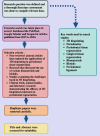3D Bioprinting: Shaping the Future of Periodontal Tissue Regeneration and Disease Management
- PMID: 40255528
- PMCID: PMC12007905
- DOI: 10.7759/cureus.82432
3D Bioprinting: Shaping the Future of Periodontal Tissue Regeneration and Disease Management
Abstract
The periodontium is one of the most complex tissues in the body, consisting of a hierarchical blend of soft and hard tissues. Its complex architecture makes treating and regenerating disease-damaged periodontal tissues a persistent challenge in biomedicine. Three-dimensional (3D) bioprinting represents a transformative approach to tissue engineering, offering promising advancements in treating and regenerating periodontal disease. This innovative technology enables the precise fabrication of complex, patient-specific tissue structures, facilitating the repair and restoration of damaged periodontal tissues, including the gingiva, bone, and periodontal ligament (PDL). By utilizing biocompatible materials such as living cells, hydrogels, and growth factors, 3D bioprinting has the potential to create functional, biologically integrated constructs that can mimic the natural architecture of periodontal tissues. However, translating these advancements into clinical applications remains a challenge. Emerging technologies like bioprinting have been developed to address some limitations of traditional tissue engineering methods. This review explores the current state of 3D bioprinting technology, its application in periodontal disease treatment, and the challenges associated with scaling up this technology for clinical use. Additionally, it discusses the future implications of bioprinting for personalized medicine, offering a new frontier for regenerating periodontal tissues and improving patient outcomes in oral health. Integrating 3D bioprinting into periodontal regenerative therapies could revolutionize clinical practices, offering more effective, tailored, and sustainable solutions to address the challenges of periodontal disease.
Keywords: biocompatible bioinks; biomaterials; extrusion-based 3d bioprinting; growth factors; hydrogel; mesenchymal stem cells; patient-specific tissue constructs; periodontitis; regenerative periodontal tissues; tissue engineering.
Copyright © 2025, Acharya et al.
Conflict of interest statement
Conflicts of interest: In compliance with the ICMJE uniform disclosure form, all authors declare the following: Payment/services info: All authors have declared that no financial support was received from any organization for the submitted work. Financial relationships: All authors have declared that they have no financial relationships at present or within the previous three years with any organizations that might have an interest in the submitted work. Other relationships: All authors have declared that there are no other relationships or activities that could appear to have influenced the submitted work.
Figures







References
-
- Evaluation of salivary parameters and oral health status in periodontally healthy subjects and chronic periodontitis subjects. Kurien VT, Shanker RK, Hegde S, Onisha V, Pillai SA. https://journals.lww.com/adhb/fulltext/2024/14030/evaluation_of_salivary... Adv Hum Biol. 2024;14:203–209.
-
- Materials for dentoalveolar bioprinting: current state of the art. Amoli MS, EzEldeen M, Jacobs R, Bloemen V. http://Materials for dentoalveolar bioprinting: current state of the art Biomedicines. 2022;10:71. - PMC - PubMed
Publication types
LinkOut - more resources
Full Text Sources
